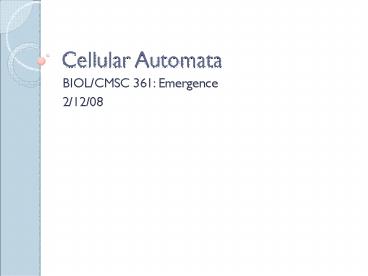Cellular Automata - PowerPoint PPT Presentation
Title:
Cellular Automata
Description:
Cellular Automata BIOL/CMSC 361: Emergence 2/12/08 The Computational Beauty of Nature The topics covered in this book demand varying amounts of sophistication from ... – PowerPoint PPT presentation
Number of Views:176
Avg rating:3.0/5.0
Title: Cellular Automata
1
Cellular Automata
- BIOL/CMSC 361 Emergence
- 2/12/08
2
The Computational Beauty of Nature
- The topics covered in this book demand varying
amounts of sophistication from you. Some of the
ideas are so simple that they have formed the
basis of lessons for a third grade class. Other
chapters should give graduate students a
headache. This is intentional. If you are
confused by a sentence, section, or chapter,then
by all means move on. pg. xv
3
A New Kind of Science
- Steven Wolfram (Mathematica)
- The nature of computation must be explored
experimentally - Methods relevant to the study of simple programs
(computation) are relevant to all other fields of
study - Non-simple behavior corresponds to a computation
of equivalent sophistication
Principle of Computational Equivalence
4
Universal Computation
- Turing Machine
- Extremely basic, symbol processing device that
can be adapted to simulate the logic of any
computer - Cellular Automata?
5
Summary
- Chaos simple things ? complex behavior
- Complexity complex collections of simple things
? variety of behaviors - Emergence collection of behaviors ? a whole
- Parts
- Interactions
6
About a Model
?
Input
Output
Top-down formulate overview of system
Bottom-up specify basic elements in great detail
and link together to formulate system
7
What do about a Model?
- Engineers study interesting real-world problems
but fudge their results. Mathematicians get
exact results but study only toy problems. But
computer scientists, being neither engineers nor
mathematicians, study toy problems and fudge
their results. pg. xiii - Engineer ? Experimentalist
- Theorist ? Mathematician
- Simulationist ? Computer Scientist
8
What to do about a Model
- Experimentalist messy real-world problems are
prone to error - Theorist must make simplifying assumptions to
get to the essence of a physical process - Simulationist attempts to understand the world
by through computer simulatyions of phenomena - Makes assumptions
- Simulated results are not perfect match for the
real world
9
Cellular Automata
- A computational model
- An abstraction of a real-world system
- NOT a type of real-world system
- Other Types of Models
- Mathematical Models
- Differential Equations
- Linear Equations
- Probability Distributions
- Physical Models
- Spatial
- Visual
10
Cellular Automata
Neighbors
Rules
Time
State Space
11
Wolframs Classification
- Class I Always evolve to a homogenous
arrangement, with every cell in same state
12
Wolframs Classification
- Class II form endlessly cycling periodic
structures
13
Wolframs Classification
- Class III form aperiodic, or random-like
patterns
14
Wolframs Classification
- Class IV global pattern is complex due to
localized structure eventually becomes
homogenous or settles into a periodic pattern
15
Langtons Scheme
- ? (N nq) / N
- N total number of rules
- nq number of rules that map to a quiescent
state - ? 0 ? all rules map to quiescent state
- ? 1 ? all rules map to non-quiescent state
- But
- CA can have high ? and simple behavior if most
rules map to same state - Sophisticated programs can produce a variety of
behaviors - Cannot account for initial state or long-term
behavior
I
III
IV
II
16
Bifurcation Diagram
Zero
Steady
Chaos
17
Interactions
- Collections, Multiplicity, Parallelism
- Parallel collections of similar units
- Perform tasks simultaneously
- Multiple problem solutions to be attempted
simultaneously
18
Interactions
- Iteration, Recursion, Feedback
- Persistence in time (reproduction)
- Self-similarity
- Interaction with environment
19
Interactions
- Adaptation, Learning, Evolution
- Interesting systems change
- Consequence of parallelism and iteration in a
competitive environment with finite resources - Multiplicity and iteration ? filter
- Loop in the cause and effect of changes in agents
and their environments































